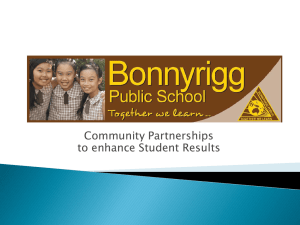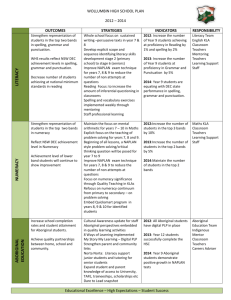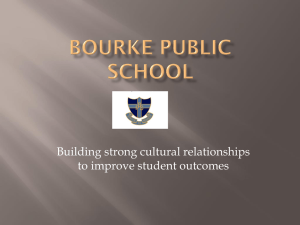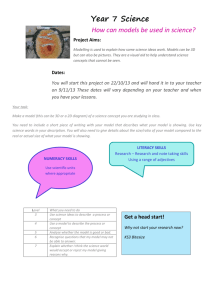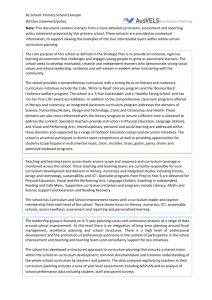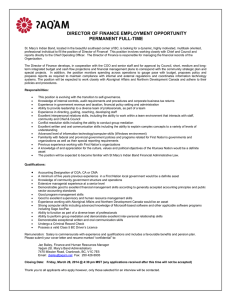NSW Department of Education & Training
advertisement
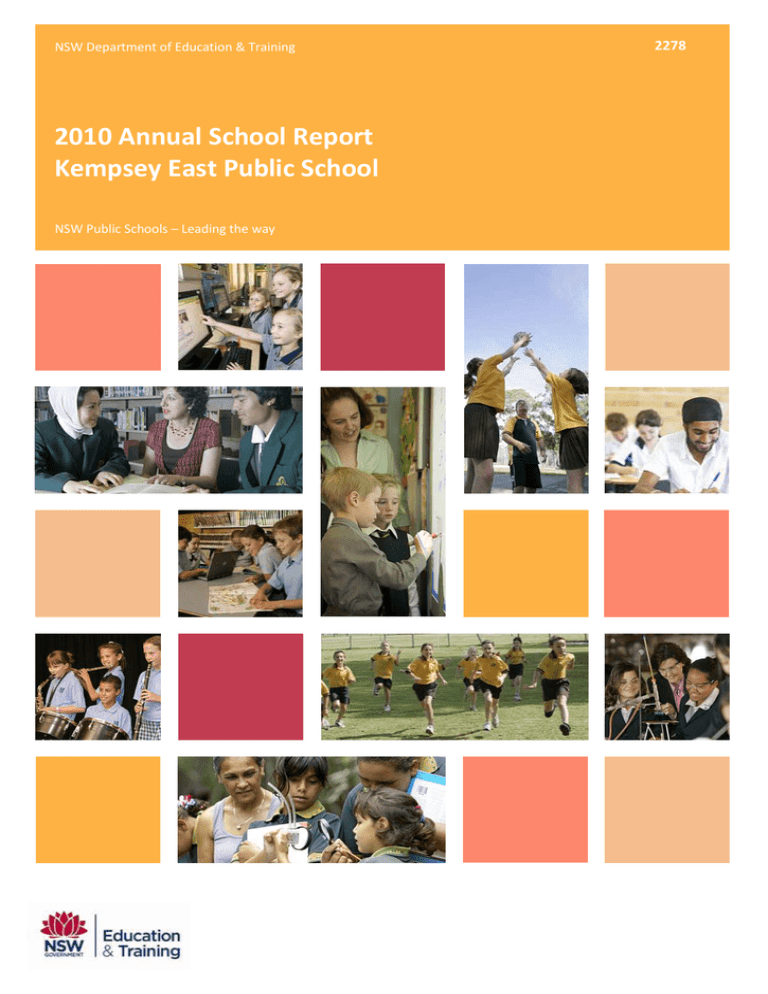
NSW Department of Education & Training 2010 Annual School Report Kempsey East Public School NSW Public Schools – Leading the way 2278 Staff professional discussion and training has continued to be focused on the provision of quality teaching in the planning and delivery of lessons and assessment procedures. There is a focus on providing educational programs to cater for the growth and education of the ‘whole child’. Our school at a glance The school is located in Kempsey, a town of approximately 10,000 people on the mid north coast. The school was established in 1881 and has a long and rich tradition of excellence in the sporting, academic and creative arts areas. The school is funded by the Priority Schools Program and is a National Partnerships Low SocioEconomic school. Kempsey East Public School is highly regarded by our parent and student body and in the local community. I certify that the information in this report is the result of a rigorous school self-evaluation process and is a balanced and genuine account of the school’s achievements and areas for development. Students Student enrolment has had only small variations over the last five years from an enrolment of 272 students in 2005 to a peak of 292 students in 2010, with 16% identifying as Aboriginal. Jenni Griffiths P & C message Thank you to the committee members who have worked hard for the P & C during 2010. Staff This year the P &C held a Mothers’ Day stall and Fathers’ Day BBQ breakfast as well as an Easter and Christmas raffle. The teaching staff at Kempsey East Public School has an average of 16 years teaching experience, and ranges from less than a year to over 35 years experience. On average staff have been at the school for nine years. Through P & C fundraising sports uniforms were supplied for students to use when representing the school in a number of sports. All teaching staff meet the professional requirements for teaching in NSW public schools. This year has seen P & C and teachers making decisions as a team to support our students. Kellie Hardy P&C President Messages Student representative’s message Principal’s message In 2010 the Students’ Representative Council (SRC) organised frolics around the themes “When I grow up” and “My favourite cartoon character”. These occasions are very popular with the students and are supported by our canteen who provide hot food, drinks and treats. In 2010 we have continued to maintain our academic focus on literacy and numeracy, resulting in the Year 3 and Year 5 students achieving very solid results in the National Assessment Program Literacy and Numeracy (NAPLAN), particularly in the higher bands. The introduction of the Language, Learning and Literacy (L3) program and the continuation of the Best Start program has resulted in Kindergarten students experiencing an excellent academic start to their schooling. Proceeds from the frolics, an Odd Shoe Day and Bandana Day were donated to the Children’s Hospital and the Cancer Council. The SRC also organised a collection of school resources donated by students and families, and arranged for it to be dispatched to less fortunate schools in Vanuatu. Our student welfare programs remain a major feature of the school, with a strengthened focus on healthy lifestyles and student wellbeing. Our emphasis on excellent student behaviour, leadership and values continues. The SRC organised and conducted the school ANZAC Day ceremony. The whole school participated in the ceremony and learnt about the significance of various traditional elements as 1 explained by SRC members during the service. The SRC also represented the school at the Remembrance Day Service at the Cenotaph. Student attendance rates Attendance rate 100 90 80 70 60 50 40 30 20 10 0 Continuing efforts by the SRC to improve safety for children walking to school has resulted in further changes to the school pedestrian crossing which is now a designated Children’s Crossing with flags and road markings to warn motorists that they must drive with caution when approaching the crossing. 2007 2008 2009 2010 Year School Region State DET 2010 SRC Captains and Ministers Management of non-attendance School context Over 2010 the school has actively encouraged student attendance through articles in the school newsletter, by installing a computerised roll marking and attendance monitoring system (Sentral), regular letters being sent to all families whose children have attendance patterns of concern or unexplained absences and providing time for staff members to phone caregivers regarding student absences. This has resulted in a decrease in unexplained absences and more regular patterns of student attendance. Student information It is a requirement that the reporting of information for all students must be consistent with privacy and personal information policies. Student enrolment profile Student enrolment has remained steady with minor fluctuations 2006 – 2010. Class sizes Enrolments 350 In March 2003 the Government announced its commitment to publish primary class sizes in annual school reports in order to provide parents with as much local information as possible. 300 Students 250 200 The following table shows our class sizes as reported at the 2010 class size audit conducted on Wednesday 17 March 2010. 150 100 50 Structure of classes 0 2006 2007 2008 2009 Students were grouped into eleven classes, five of which were composite groups to optimize the learning and social opportunities for all students. 2010 Year Male Female Student attendance profile Student attendance has improved over 2010 with the introduction of new processes to reduce and monitor student absences. 2 Roll Class KM K/1 S K/1 S 1P 1P 1/2 G 1/2 G 2B 3W 3W 3/4 R 3/4 R 4Y 4/5 W 4/5 W 5/6 L 5/6 L 6P Year K K 1 1 2 1 2 2 3 6 3 4 4 4 5 5 6 6 Total per Year 21 14 6 19 1 16 11 25 25 1 17 12 28 7 24 14 17 28 Teacher qualifications Total in Class 21 20 20 20 20 27 27 25 26 26 29 29 28 31 31 31 31 28 All teaching staff meet the professional requirements for teaching in NSW public schools. Qualifications Degree or Diploma Financial summary This summary covers funds for operating costs and does not involve expenditure areas such as permanent salaries, building and major maintenance. Date of financial summary: Income Balance brought forward Global funds Tied funds School & community sources Interest Trust receipts Canteen Total income Staff information It is a requirement that the reporting of information for all staff must be consistent with privacy and personal information policies 30/11/2008 $ 0.00 0.00 0.00 0.00 0.00 0.00 0.00 0.00 Expenditure Teaching & learning Key learning areas Staff establishment Position Principal Assistant Principal(s) Classroom Teachers RFF/Part time teacher/PSP Reading Recovery Support Teacher Learning Assistance Teacher Librarian Low SES staff School Administrative & Support Staff Total % of staff 100 Excursions Extracurricular dissections Number 1 3 8 1.4 .5 .8 .6 2 2.7 20 Library Training & development Tied funds Casual relief teachers Administration & office School-operated canteen Utilities Maintenance Trust accounts Capital programs Total expenditure Balance carried forward The National Education Agreement requires schools to report on Indigenous composition of their workforce. 0.00 0.00 0.00 0.00 0.00 0.00 0.00 0.00 0.00 0.00 0.00 0.00 0.00 0.00 0.00 A full copy of the school’s 2010 financial statement is tabled at the annual general meetings of the School Council and/or the parent body. Further details concerning the statement can be obtained by contacting the school. There are two School Learning Support Officers (Aboriginal) at the school. Staff retention Staffing at the school remains relatively stable, with small changes made by employing temporary teachers for specific initiatives or to cover long term leave. There were no teacher transfers or merit selections during the year. School performance 2010 There are a variety of educational opportunities and experiences offered to the students each year at Kempsey East Public School. 3 The school cricket team advanced to the second round of the state knockout competition. Achievements Arts Two girls were selected for the Macleay girls’ football team and five boys trialled for the Lower North Coast football side. One girl and two boys were selected for their respective Lower North Coast football sides, with the boys going on to play for the North Coast side. A Japanese group performed Taiko drumming, fan dancing and sword dancing at the school in March entertaining students and giving them an insight into other cultures. Musica Viva came to the school during second term involving the students in music from several cultures developing improvised compositions in an energetic and highly interactive program. One student represented the Macleay area in rugby league. The school netball side became the Macleay champions with four girls selected in the representative side. The team was knocked out in the second round of the Hastings Macleay competition. Three students represented the school in the Macleay Idol with two students sharing equal first in their division. Many students presented artwork for the Kempsey Show with six students having their work recognized with places. Thirty students represented the school in cross country at Lower North Coast level, with three students proceeding to North Coast level, and one student going on to the state carnival. Two students achieved wonderful results at the Kempsey eisteddfod with eight first places, two seconds and one third placing for their respective performances. Softball was played by both boys and girls this year. The girls side made it through to the fourth round of the state knockout competition. Three softballers represented the Lower North Coast in their respective sides and one player was selected for the North Coast team. Six senior band members continued to practise and play at school events. Four students completed a mime and movement workshop at Kempsey High School. Eleven students represented the school at Lower North Coast athletics with six students progressing to the North Coast level and two continuing to the NSW carnival. Twelve students had their art work exhibited at the Macleay Education Community of Schools’ Spring Into Art Festival. Four students achieved Sporting Blues from the school in cross country, football and softball. Sport Four boys participated in the Macleay cricket trials with two selected for the lower north coast team, with one proceeding to selection in the North Coast side. Other Local interschool rugby for under ten years and under twelve years was conducted on Friday evenings in term one. After school activities began in February with a group of students enjoying the opportunity to participate in a wide range of sports and activities. One student achieved a Rotary Club citizenship award. The school rugby side became local champions with eight players selected for the Lower North Coast team and two boys selected for the Macleay under twelve side. The University of NSW: Seven swimmers represented the school at the Lower North Coast carnival with one achieving their age championship. 4 Computer Skills Competition saw fifteen students participate earning one distinction, four credits and eleven participation certificates; Yr 3: from Band 1 (lowest) to Band 6 (highest for Year 3) Science Competition had fourteen students participate earning three credits and eleven participation certificates; Yr 5: from Band 3 (lowest) to Band 8 (highest for Year 5) Writing Competition saw fourteen students participate earning two distinctions, two credits and ten participation certificates; Spelling Competition had twenty three students participate earning two distinctions, five credits and sixteen participation certificates; English Competition saw eighteen students participate earning four credits and fourteen participation certificates; and Mathematics Competition had twenty eight students participate earning one distinction, eleven credits and sixteen participation certificates. Literacy – NAPLAN Year 3 Year 3 literacy results exemplified the disparity of student achievement. There was an increase in the number of students gaining results in the highest band in all aspects of literacy, sometimes not only bettering like schools but the state average. There has also been an increase of results in the lower bands, and this reflects the changing nature of student enrolment and the need to continue with intensive remediation programs. Percentage of students in bands: Year 3 reading 30 Stage three students had a most enjoyable camp at Lake Keepit learning a great deal about the environment and personal development skills. Percentage of students 25 Jump Rope for Heart Jump Off Day was held in late April with many students participating. In second term the school became a Waterwise School encouraging students to conserve water and be aware of its value as a resource. The school captains and ministers led the school Anzac Day ceremony with students and parents participating in the Kempsey Anzac Day ceremony. 20 15 10 5 0 1 A group of Stage 2 students enjoyed Ausquiz over the year building their awareness of history and current affairs. 2 3 Band 4 5 Percentage in band School average 2008 - 2010 One student achieved first in the top 100 students in Australia for Mathletics and fourth in the top 100 in the world. Over the year many students achieved increased Mathletics levels and Hall of Fame placements. SSG average 2010 State DET average 2010 Academic In the National Assessment Program, the results across the Years 3, 5, 7 and 9 literacy and numeracy assessments are reported on a scale from Band 1 to Band 10. The achievement scale represents increasing levels of skills and understandings demonstrated in these assessments. 5 6 Percentage of students in bands: Year 3 spelling 35 30 30 25 Percentage of students Percentage of students Percentage of students in bands: Year 3 writing 25 20 15 10 15 10 5 5 0 0 1 2 3 Band 4 5 1 6 3 Band 4 5 Percentage in band School average 2008 - 2010 School average 2008 - 2010 SSG average 2010 SSG average 2010 State DET average 2010 State DET average 2010 There has been a significant growth in the percentage of students achieving in the highest bands in Year 3 numeracy. The school percentage in the highest band was significantly greater than the state percentage of students achieving in this band. There has also been student growth in the lower bands reflected by the movement of students up from Band 1 and into Bands 2 and 3. 30 25 20 15 10 5 0 2 3 Band 4 5 6 Numeracy – NAPLAN Year 3 35 1 2 Percentage in band Percentage of students in bands: Year 3 grammar and punctuation Percentage of students 20 6 Percentage in band School average 2008 - 2010 SSG average 2010 State DET average 2010 6 Percentage of students in bands: Year 5 reading 35 35 30 30 Percentage of students Percentage of students Percentage of students in bands: Year 3 numeracy 25 20 15 10 25 20 15 10 5 5 0 0 1 2 3 Band 4 5 3 6 Percentage in band 4 5 Band 6 7 8 Percentage in band School average 2008 - 2010 School average 2008 - 2010 SSG average 2010 SSG average 2010 State DET average 2010 State DET average 2010 Literacy – NAPLAN Year 5 Percentage of students in bands: Year 5 writing Literacy results are stronger than like schools in the majority of areas with significantly better results in the top bands of all areas except writing. There were less students in the lower bands than similar schools in all aspects of literacy. 45 Percentage of students 40 35 30 25 20 15 10 5 0 3 4 5 Band 6 7 Percentage in band School average 2008 - 2010 SSG average 2010 State DET average 2010 7 8 Percentage of students in bands: Year 5 numeracy 35 40 30 35 Percentage of students Percentage of students Percentage of students in bands: Year 5 spelling 25 20 15 10 30 25 20 15 10 5 5 0 0 3 4 5 Band 6 7 3 8 Percentage in band 5 Band 6 7 8 Percentage in band School average 2008 - 2010 School average 2008 - 2010 SSG average 2010 SSG average 2010 State DET average 2010 State DET average 2010 Percentage of students in bands: Year 5 grammar and punctuation Progress in literacy 35 The progress in writing was above both that of similar schools and the state and progress in the other areas of literacy was slightly lower than that of similar schools and the state. 30 25 20 15 Average progress in reading between Year 3 and Year 5 10 120 5 100 0 80 3 4 5 Band 6 7 Progress Percentage of students 4 8 Percentage in band School average 2008 - 2010 60 40 20 SSG average 2010 0 State DET average 2010 2006 - 2008 2007 - 2009 2008 - 2010 Numeracy – NAPLAN Year 5 School Student performance in the highest band was very strong, surpassing not only similar schools but the state percentage. Student representation in Band 4 was higher than it has been in previous years. 8 SSG State DET Progress in numeracy Average progress in writing between Year 3 and Year 5 The progress in numeracy for matched students has been slightly less than for similar schools and the state. 80 70 Progress 60 Average progress in numeracy between Year 3 and Year 5 50 40 100 90 80 70 60 50 40 30 20 10 0 30 20 Progress 10 0 2006 - 2008 2007 - 2009 2008 - 2010 School SSG State DET Average progress in spelling between Year 3 and Year 5 86 2006 - 2008 2007 - 2009 2008 - 2010 School 86 SSG State DET Progress 85 85 84 Minimum standards 84 The Commonwealth Government sets minimum standards for reading, writing, grammar and punctuation, spelling and numeracy for years 3, 5, 7 and 9. 83 83 82 82 2008 - 2010 School SSG The performance of the students in our school in the National Assessment Program – Literacy and Numeracy is compared to these minimum standards. The percentages of our students achieving at or above these standards are reported below. State DET Average progress in grammar & punctuation between Year 3 and Year 5 98 96 Percentage of Year 3 students in our school achieving at or above the minimum standard in 2010 Progress 94 92 90 88 86 Percentage of Year 3 students achieving at or above minimum standard Reading 93 Writing 93 Spelling 88 Punctuation and grammar 79 Numeracy 93 84 82 2008 - 2010 School SSG State DET 9 Percentage of Year 5 students in our school achieving at or above the minimum standard in 2010 NAIDOC celebrations were an outstanding success with many interesting activities based on Aboriginal culture and successful Aboriginal people being conducted. Multicultural education Percentage of Year 5 students achieving at or above minimum standard Reading 94 Writing 100 Spelling 97 Punctuation and grammar 94 Numeracy 94 The school’s curriculum scope and sequence has formalised our approach to multicultural perspectives across all Key Learning Areas (KLAs) in 2010. Students participate in a variety of activities to increase their understanding of different cultures and lifestyles. Respect and responsibility Significant programs and initiatives Values education underpins the core values, policies and programs operating within the school. The Rock and Water program implemented across the whole school emphasises respect, responsibility, co-operation and integrity. The school has a strong antibullying program that teaches the right to be safe, respected and treated fairly. Environmental Education continues to be a focus with the school becoming a Water Wise school this year. Aboriginal education All Year K-6 teaching programs include Aboriginal perspectives and content that teaches children about Aboriginal history, culture and Aboriginal Australia in the twentieth century. Student involvement in the National Aboriginal and Islander Day Observance Committee (NAIDOC) celebrations provides opportunities for all students to increase their understanding of Aboriginal Australia. Students participate in community service activities such as visiting local nursing homes and participating in the Clean Up Australia Day and being involved in the Anzac service. Our Aboriginal Education Officer continued to provide support for Aboriginal students in literacy and numeracy across all stages and during 2010 and an additional Aboriginal School Learning Support Officer (SLSO) was employed. National partnership programs Funding from the Low Socio-Economic Partnership has enabled the school to introduce additional programs to improve student outcomes. Two staff members participated in the Stronger Smarter training and this became the catalyst for a renewed focus on Aboriginal Education. All staff have now discussed and understand the elements of the Aboriginal Education Policy. Personal Learning Plans (PLP) have been developed with the families of all Aboriginal students and an Aboriginal Education Committee has been formed. Four staff members were trained to conduct the Quick Smart numeracy intervention program. Twenty students between Years 4-6 participated in the program with all students improving at a rate faster than other students who were not participating in the program. Aboriginal students performed well in the NAPLAN tests with Year 5 Aboriginal and Torres Strait Islander (ATSI) students surpassing the average growth expected for all students in NSW in the areas of spelling, reading and grammar and punctuation and bettering the average for all Aboriginal students in every aspect of the NAPLAN tests. An Accelerated Literacy tutor was trained early in the year and this enabled eight teaching staff to participate in school-based training. While this program is in the early stages, 2010 NAPLAN results indicate that 60% students grew more than the expected rate between Years 3 and 5 in writing and that there was a 50% reduction of students in the lower bands in Year 5 in writing. There has been an increased focus on the monitoring of student attendance, and 10 absenteeism reduced in the latter part of the year. Target 2 To increase the percentage of Year 3 students in the top two bands of Number, Patterns and Algebra from 28% to 32% and to increase the percentage of Year 5 students in the top two bands in Number Patterns and Algebra from 29% to 36%. Priority Schools Program (PSP) An extension program involving 56 Stage 2 and 3 students in literacy and numeracy was conducted using the staffing supplement provided by PSP. This enabled the higher achievers to work at an extension level and also supported the other students who were able to work in smaller home class groups, providing more opportunities for individualized attention. In NAPLAN Year 3 students out-performed the state in the percentage of students achieving in the highest band in Grammar and Punctuation and numeracy and similar schools in all areas except spelling. In NAPLAN Year 5 students out-performed the state in the percentage of students achieving in the highest band in all areas of numeracy, equal in Grammar and Punctuation and had greater representation in the highest band compared to similar schools in spelling and reading. A community Liaison Officer was employed to liaise with parents about their children, school satisfaction, to provide training for parents and to strengthen the home school partnership. Our achievements include: NAPLAN assessments indicate 19% of Year 5 students were assessed in Band 8 for overall numeracy, surpassing the target by 2%. NAPLAN assessment indicates 17% of Year 3 students are placed in Band 6 for overall numeracy, surpassing the target by 3%. A scope and sequence has been developed for the teaching of mathematics in each stage. All classes from years 1-6 participate in the online Mathletics program. Cooperative stage planning of mathematics using CTJ has developed assessment strategies in the strands of Number and Patterns and Algebra. Target 3 To increase the percentage of Year 5 students represented in Band 8 from 2% to 7% in overall literacy and 9% to 14% in overall numeracy and to increase the percentage of Year 3 students represented in Band 6 from 19% to 23% in overall literacy and 12% in overall numeracy. Progress on 2010 targets Target 1 To increase growth from Year 3 to Year 5 in writing from 12.9% to 50% of students achieving minimum growth. Our achievements include: Averaged NAPLAN literacy assessments indicate, 22% of Year 3 students are placed in Band 6. This surpassed the target by 2%. Our achievements include: NAPLAN assessments show 60% of Year 5 students have achieved at or above minimum growth, surpassing the target by 10% Averaged NAPLAN literacy assessments indicate 10.5% of Year 5 students are placed in Band 8. This surpassed the target by 3.5%. NAPLAN assessments indicate average growth in writing for the school to be 2.2 points above the north coast region average. All students have reached reading level 9 in Kindergarten. Eight staff and one tutor have been trained in the Accelerated Literacy program. Teacher reflection indicates that there has been greater involvement of students in the development of assessment criteria, how they learn and why they learn. There has been a focus on the teaching of writing and on the effective use of paragraphs. 11 Key evaluations Curriculum It is a requirement for all NSW public schools to conduct at least two annual evaluations – one related to educational and management practice and the other related to curriculum. In 2010 our school carried out evaluations of student engagement and Stage 1 and Early Stage 1 literacy. Early Stage 1 and Stage 1 literacy Background Australian Early Development Index data (2009) indicated 9.2% of Kindergarten students across Australia were vulnerable in language and cognition and 9.4% in communication but at Kempsey East Public School these proportions were 20% and 10%. Educational and management practice Student engagement A greater proportion of students entering Kindergarten in Kempsey had not experienced pre-school than was the Australian average. Background Students over Years 2 to 6 (51% male; 13.7% identifying as being Aboriginal) completed surveys regarding aspects of engagement with school and with learning. Kindergarten staff were trained in the L3 program and this was implemented along with Best Start practices. Findings and conclusions Findings and conclusions Very strong (90% or greater) agreement with positive statements about attending and learning through interesting methods; their teacher liking them, treating them with respect and letting them know what they need to do to produce quality work; and access to and enjoyment using computers. At the start of the L3 program only two students recognized more than fifteen words with 24 students being placed in Band 1 or below in reading assessment. Very strong (90% or greater) agreement with positive statements regarding the importance, their liking, their skill and effort in mathematics; the clarity of expectations, learning direction and explanation by teaching staff as well as the variety of strategies experienced. Best Start initial assessments indicated that 60% of students were below the expected level in most assessments, but at the end of Kindergarten this proportion had been significantly reduced. A series of questions particularly about Mathletics indicated very strong support for the program. Introduction of a ‘pre-school transition’ initiative to develop strong early learning foundations and strengthening the transition from home to school by familiarising parents and students with school routines, the environment and expectations. At the end of the year fifteen students recognized over 50 words and five students were placed above the expected reading level. Future directions Very strong (90% or greater) agreement with positive statements regarding the importance of English, the activities experienced, reasons for learning, teacher expectations, teacher guidance and recognition of their own improvement. Parent workshops are to be conducted in conjunction with the transition initiative. The L3 program will continue with another staff member being trained. Future directions A Year 1 and 2 literacy remediation group will be established using Best Start strategies. The school will: maintain the focus on the importance of school attendance; ensure that a relevant, challenging and engaging learning continues; and persist with the emphasis on home reading programs and parent involvement in homework procedures. Teachers are to be trained in the Best Start oral language program. 12 Parent, student, and teacher satisfaction The staff were undecided (45% - 54% agreement) that they had: In 2010 the school sought the opinions of parents, students and teachers about the school. Their responses are presented below. Fifty community members, 17 identifying as being Aboriginal completed a survey (28 questions 5 response alternatives) indicating overwhelming support (more than 90% agreement) for positive statements regarding: student safety and the educational experience, especially Mathletics; the school’s welcoming atmosphere willingness to listen; school leadership changes; and school uniform. introducing and found that more students are completing homework; found that more students are reading at home; increased understanding of DET Gifted & Talented policy; and found Accelerated Literacy strategies have improved their teaching of literacy. Implications for staff development: further development of ICT skills, knowledge and application across all KLAs; consistency of approach to home reading and homework; further development of teacher skills and understanding of Intellectual Quality. additional Accelerated Literacy training to consolidate skills; catering for the variation of student abilities within classrooms – extension for gifted and talented students, while providing remedial support; and closer affiliation with Aboriginal families. positive There was strong (80 - 89%) agreement across the community for statements concerning: student enjoyment of school; school and staff continual improvement; fairness of treatment; and school organization and communication. Community members generally were not supportive (less than 60% support) for statements concerning: children reading more at home this year; domestic use of the internet (a significant proportion indicating they were not connected); and observing media coverage of the school. Implications for home, school and community partnerships: Overwhelmingly staff agreed (90% or more agreement) that they had: provided quality learning experiences, increasing their classroom use of technology; an increased understanding of the Intellectual Quality dimension of Quality teaching and used this when developing programs; developed a greater Aboriginal culture; found the TARS process helpful in assisting their professional development; and understanding encouraged increased student involvement in what and how they learn; of 13 The school needs to continue its increased promotion strategy ensuring media exposure; To continue to have 100% Aboriginal parent involvement in the PLP process; and To continue to develop and promote the home school reading program. School development 2009 – 2011 Targets for 2011 teacher professional development in literacy, particularly in teaching persuasive texts and reading comprehension is provided. Our success will be measured by: Target 1 To improve student growth in 2011 NAPLAN results between Year 3 and Year 5 indicated by an increase in the number of students achieving equal to or greater than expected growth: teacher reflection and programs indicating: - all Accelerated Literacy trained teachers are implementing Accelerated Literacy units in sequence; - the use of authentic texts in Accelerated Literacy programs; in reading from 40 % to 50%, in spelling 51.4% to 55%; and - improved teacher confidence in using Accelerated Literacy in literacy sessions; in grammar and punctuation 45.7% to 51% - teaching strategies that focus on increasing all levels of student comprehension; and - stage literacy resources are developed collaboratively and shared. Strategies to achieve this target include: three additional teachers being trained in Accelerated Literacy strategies; ongoing training and consolidation of Accelerated Literacy skills for teachers previously trained; implementing a library reading incentive program; conducting the Reading is Rad program over the holidays; promoting and recognising home reading; providing Stage 1 & 2 with additional reading intervention; the extension literacy program is maintained in Stage 2 & 3; the Multi Lit program is introduced targeting 20 students in Years 3 to 5; NAPLAN growth maintained; 95% students meet literacy benchmarks in in student writing is Year 3; staff meeting discussions occurring on stage relevant literature focussing on and modelling teaching strategies to improve comprehension; an increase in the regular use of reading diaries and parental involvement in this program; eight students are successfully exited from the Reading Recovery program; participating students are reading at levels 1618 and performing satisfactorily in the Year 1 classroom; Year 2 & 3 reading intervention students attain minimum reading level 25 or achieve their identified individual reading target; NAPLAN data indicates results equal to or exceeding the percentage of students in the top two bands in all areas of literacy in Year 3 and Year 5; consistency of teacher judgements (CTJ) stage assessment indicates that all students in the extension groups are achieving above the syllabus standard; Literacy Language and learning (L3) is supported and additional staff are trained; the Best Start program is continued and expanded; all Kindergarten3 teachers are trained in L3 strategies; an oral language program is introduced in Early Stage 1 and Stage 1; and L3 data indicates growth in all areas of assessment with the 80% students attaining benchmarks; 14 the Best Start learning continuum indicates a movement of a minimum of one level in all literacy areas; a parent survey indicates increased confidence with helping their Early Stage 1 and Stage 1 students with maths; Best Start assessment indicates 60% students move at least two levels; Early Stage 1 and Stage 1 teacher reflection indicates an increased knowledge and use of: Stage 1 data indicates an improvement in identified students’ oral language; and - space and geometry teaching strategies; NAPLAN data indicates student growth is equal to the state in reading. - the best start learning continuum; and - the number framework; - student maths learning journals. Target 2 To decrease the percentage of Year 3 students in Bands 1 & 2 from 33% to 26% in the NAPLAN numeracy results. a reduction of Year 3 students in NAPLAN Bands 1 & 2; testing indicating all Quick Smart participants achieve a minimum growth of two stanines; Year 3 NAPLAN results indicate a movement from 26% to 17% of students in the bottom 2 bands and in Data, Space and Measurement and 31% to 14 % in Number Space and Algebra students in the bottom 2 bands; at least 25 students participate in the UNSW Mathematics Competition participation; and Mathletics data indicates an average student improvement of 32% or greater. Strategies to achieve this target include: creation of a Stage 1 remediation maths group; teaching staff accessing professional development in early Stage 1 and Stage 1 Number, Space and Geometry strategies; teaching staff accessing professional development in Best Start strategies; parent workshops being held on Number, Space and Geometry providing information on early Stage 1 and Stage 1 strategies; maths learning journals are used in all stages; the Quick Smart program continues with additional staff trained; Stages 2 and 3 develop a school based program to address improved automatic recall of number facts; stage meetings analyse NAPLAN data to guide teaching strategies; and extension classes in Stage 2 & 3 continue. Target 3 From 90% to 100% of Aboriginal students have a meaningful, current Personalised Learning Plan which is frequently updated and developed in genuine partnership with caregivers and school staff. Strategies to achieve this include: ensuring all Personal Learning Plans (PLPs) are always current. an Aboriginal School Learning Support Officer (SLSO) is employed to support the PLP process. maintaining continued staff representation at network Aboriginal Education meetings attendance of school representatives at AECG meetings. continued cultural awareness training for all staff introducing the Dunghutti language in Years K and 5/6. Our success will be measured by: 80% Stage 1 students move at least 1 level in the number framework; a school developed Space framework indicates 80% Early Stage 1 and Stage 1 students moved at least one level; Best Start data indicates a minimum of 80% students move at least one level; 15 a Welcome to Country is made at all gatherings, preferably in Dunghutti language including regular items in the newsletter about school attendance; reviewing the student welfare policy to include incentives for satisfactory school attendance; the PLP process includes attendance data and parent communication; Our success will be measured by: staff reflection indicates an increased: - understanding of cultural awareness; - understanding of the benefits of a consultative PLP process; - positive relationship and linkages between the school and the family; a whole school review of behaviour and welfare programs with a team participating in Positive Behaviour for Learning; - increased involvement Committee meetings; Aboriginal continued usage of ICT to support the teaching of maths; and - knowledge of the Dunghutti language and culture; and - inclusion of Aboriginal perspectives into teaching programs. PLPs (numeracy) are developed for all Aboriginal students and students with special needs. in introduction of a transition program; regular use of the Welcome To Country; About this report increased awareness Education Policy; all Aboriginal students achieve their individual realistic learning targets as established in their PLPs; Common Dunghutti words used and displayed daily in class; and In preparing this report, the self-evaluation committee has gathered information from evaluations conducted during the year and analysed other information about the school's practices and student learning outcomes. The self-evaluation committee and school planning committee have determined targets for the school's future development. Student PLPs indicate an increased awareness of their culture. of the Aboriginal Jenni Griffiths Principal Timothy Trotter Assistant Principal Target 4 Wendy Stanborough Assistant Principal To reduce the number of students from 13 to 0 in Kindergarten and Year 1 who have more than 30 absences over three terms. Jenny Young Teacher Diane Goodman Teacher Catherine Collier Parent Strategies to achieve this include: monitoring and follow up of attendance by community liaison officer, executive, class teachers with a focus on Early Stage 1 and Stage 1 contact; Kate Hollis Parent maintenance of the Sentral attendance system; Innes Street Kempsey reviewing the staff procedures in relation to notifying the community about attendance concerns; School contact information Kempsey East Public School Ph: 02 65624927 Fax: 0265628979 Email: kempseyest-p.school@det.nsw.edu.au Web: www.kempseyest-p.schools.nsw.edu.au 16 School Code: 2278 Parents can find out more information about Annual School Reports, how to interpret information in the reports and have the opportunity to provide feedback about these reports at: http://www.schools.nsw.edu.au/asr 17
